At our CEFA Early Learning schools, we teach children attributes as part of our S.T.E.M. program, and one of the ways we do it is using all types of sorting games. Each type will teach our students to sort using different attributes.
Sorting is a foundational math skill and is very important to learn, as it helps children describe things and then compare, using attributes (like color, size, shape, etc.). We use sorting games all year long, and in every grade. They get more and more complex as children gain sorting skills, and are more descriptive in their attributes.
These games help our students sort, classify and order objects by size, shape, color and other attributes. Sorting games are great as activities that your child can play on their own, and can be made with practically anything around the house.
This activity was made as a follow-up to practicing scissor skills with straws since you would be left with a lot of straws that can be sorted according to many attributes – read on!
Best Ages for This Activity
Two to five (just adjust the level of complexity).
How to Make It
Ingredients
- Colorful straws, cut into pieces. Or use the leftover straws from this activity.
- Transparent containers (can be cups) to sort the straws into
Let’s Get Started!
- Put all objects to be sorted in a container or tray.
- Provide a muffin tin, glasses or plastic cups, etc. for your child to begin sorting.
- Invite your child to sort the straws. If your child is very little and just beginning to sort, you can ask “what goes together?”
- Begin with two or three colors if your child is very young and add complexity as your child gains skills. Below are some examples of how you can sort the straws:
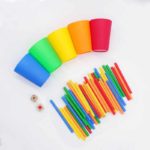
- Try sorting by color:
- Try sorting by length
You can do this either:
- By estimating the length of the straw, if your child is just starting (for example, affix (with tape) a few straws of various lengths, starting from shortest to longest, to the table, then encourage your child to find out where the loose straws belong. They can do this by comparing the loose straw to each straw on the table until they find one of the same length.
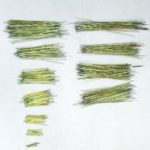
- By measuring the straw with a ruler and sorting it onto cups that show those measurements. For example, a cup for 1 centimetre straws, one for 2 centimetre straws, another for 3 centimetre straws, etc. This is more complex but will teach your child to measure.
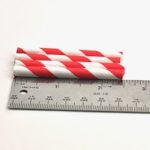
If you child is finding it difficult, try the next activity:
- By comparing the straws they need to sort to lines on a long piece of paper reading the measurements. For this, you will need to (with your child) take a ruler and measure 1 cm. you then draw a line on the paper that is 1cm long (so, using the ruler, draw a line from 0 to 1cm). Leave some distance (so your child can place the straws where the line is) and draw a second line measuring 2cm, then a third measuring 3cm and so on and so forth until you have a line as long as your longest straw. Your child can compare the loose straws to each line and find the right line. To make it more complex, you can indicate at the bottom of each line how long it is (for example, the 1cm line will say 1cm below it. The 2cm line will say 2cm, etc.)
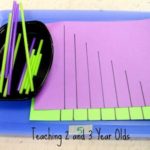
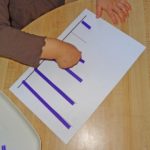

- Try sorting by texture (for example, paper straws and plastic straws):
- Try sorting by functionality (for example, straws that bend and straws that don’t bend; straws that are recyclable versus straws that aren’t; straws that are washable versus straws that aren’t)

- Try sorting according to the pattern on the straw:

- Try sorting by width of the straw (if you use straws of different widths):
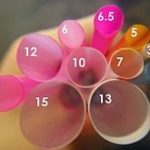
Learning Opportunities
Children will learn S.T.E.M., especially in the area of mathematics. While you play with your child, encourage your child to describe why they are sorting the objects in that specific manner (example, by color, by type, etc.). You can also invite your child to sort using different attributes during play.
In this game, the greatest learning opportunities are in reasoning (which objects go where and why) and use of mathematical vocabulary.
This activity also encourages your child to focus and stay on one task (increases attention span) which contributes to your child’s social and emotional development.
CEFA tip: Although sorting is a great activity for your child to do alone, make sure you always supervise.
Books Your Child Might Like
In order to truly understand these concepts, it is always best for your children to have as many hands-on activities and manipulatives as possible. For sorting, an activity that they can touch, feel and play with is so much better than a worksheet or book. If your child really has a passion for sorting, however, or if you need an activity that is educational but does not require as much supervision, then books and workbooks can be fun! Plus, it really depends on your child. Some children love working on workbooks (I was one of them) and can find them entertaining for hours on end, while others prefer real objects. Whatever your child’s preference may be, make sure you always provide manipulatives (rather than only workbooks or activities on paper). Trust me on this one.
As an Amazon Associate I earn from qualifying purchases